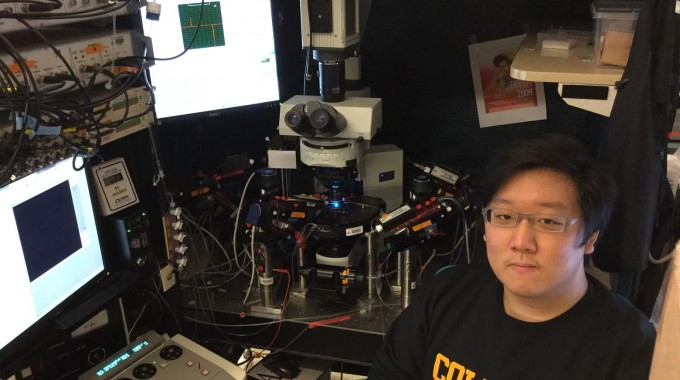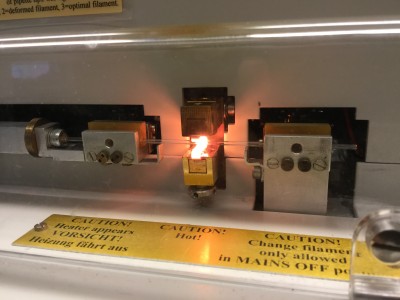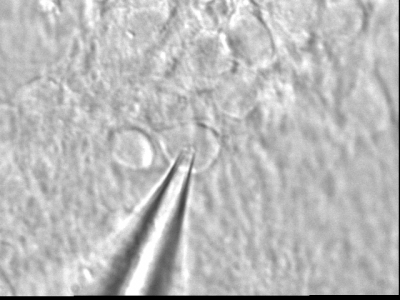If you know of a Columbia College student, faculty member, alumnus/alumna or program we should spotlight, or if you would like to submit a story, please contact:
Columbia College
Office of Communications
cc-comms@columbia.edu

“I was fortunate to be forced into the discomfort and challenge presented by scientific research and to learn lessons that I hope will serve me well in my aspirations for the future.” — Junghoon Kim CC’16
In the summer of 2015, Junghoon Kim CC’16 received a Class of 1939 Summer Research Fellowship that allowed him to continue conducting neuroscience research in Columbia’s Yuste lab, where he has been conducting research since his first year at the College. Here, Junghoon reflects on the value of grappling with the inherent uncertainty of research.
Imagine a crowded corner of a room, packed with robotic arms, a powerful camera, a microscope and many sorts of wires, cables and tubing. This is the setting in which I have spent 15 hours a week conducting research at Professor of Biology and Neuroscience Rafael Yuste’s neuroscience laboratory in the Northwest Corner building since my first year at Columbia College.
Referred to as the “North Rig,” this area of the lab is an operating table of sorts, where neurons are kept on a delicate balance of life support as they are altered and manipulated on a microscopic scale. Here I would often be seated, only hands, head and eyes moving cautiously and nervously from one device to another and from screen to screen. While far from being something of my own, the North Rig has been central to my Columbia experience and has always felt like a home away from home, a place where I could be comfortable in my scientific exploration while also pushing myself to explore new challenges.
 The process of heating and pulling micropipettes. Photo: Junghoon Kim CC’16
Since March 2015, I have been involved in research that aims to apply physical and chemical aspects of nanoparticles in the context of neuroscience. It was the proposition of Wieteke D.A.M. de Boer, a postdoctoral researcher in the Yuste lab, in collaboration with Columbia’s Owen Group lab, which researches the inorganic chemistry of nanocrystals. Through a timely coincidence owing to some prior experience in the lab with related techniques, I had been assigned to collaborate on the study, and with the support of the Class of 1939 Summer Research Fellowship, was able to start implementing proposals made during a presentation I gave in March 2015 to the lab’s researchers — graduate students, postdoctoral researchers and Prof. Yuste himself — into my research during the summer of 2015.
The process of heating and pulling micropipettes. Photo: Junghoon Kim CC’16
Since March 2015, I have been involved in research that aims to apply physical and chemical aspects of nanoparticles in the context of neuroscience. It was the proposition of Wieteke D.A.M. de Boer, a postdoctoral researcher in the Yuste lab, in collaboration with Columbia’s Owen Group lab, which researches the inorganic chemistry of nanocrystals. Through a timely coincidence owing to some prior experience in the lab with related techniques, I had been assigned to collaborate on the study, and with the support of the Class of 1939 Summer Research Fellowship, was able to start implementing proposals made during a presentation I gave in March 2015 to the lab’s researchers — graduate students, postdoctoral researchers and Prof. Yuste himself — into my research during the summer of 2015.
My goal was to go in to the neuronal microcosm with a micropipette — a microscopic glass needle — sharply polished enough to grace a cell’s membrane without damaging it, and carefully punch a hole in this membrane, forming a stable connection. This would allow me not only to inject pulses of current and artificially excite the cell, but also to take precise measurements of the neuron’s resulting electrical activity. On such a scale, it would take only the smallest of insults to throw off a day’s experiment completely. Perhaps my glass needle might repeatedly turn out a few nanometers too thin or wide. Or my solution — the cell’s life support — might be either more or less concentrated than was optimal, in which case I would be forced to spend the next few days carefully remaking and testing a fresh batch. The setup might also be held at too low or too high a temperature to keep the cells alive. In certain instances, I found myself spending many hours and sometimes even days figuring out how to disassemble and reassemble parts of the North Rig itself to troubleshoot or to replace malfunctioning equipment.
The neurons, as brittle and high-maintenance as they are, would sometimes already be in pretty bad shape even before the experiment began because they had undergone various prior treatments. Other times they would fluctuate in health for no clear reason. When recording, it would take just a small, misplaced nudge to the needle to unleash utter pandemonium. If the seal between the micropipette and the cell was broken, the cell’s membrane would rip apart and eventually the contents of the cell would spill out into the solution, water and ions rushing in and out; the neuron, in other words, would explode beyond salvation.
But if the planets aligned and I managed to jump through all the hoops at once, I would be free to explore a stunningly alien landscape. Inject a small pulse of current, and the cell responded with a spike of electrical activity; extend the duration of the pulse and a flurry of rapid spikes returned in proportion. The question then was to investigate how nanoparticles would add to this scenery.
 View of a neuron that has been patch-clamped (punctured and connected). Photo: Junghoon Kim CC’16
As I worked throughout the summer with my partners at the North Rig, many questions presented themselves: What exactly were we looking for? How would we control the particles and make sure they stayed where we wanted them? What outcomes would result from different variations of experiments? Other than a number of speculations and suggestions, for the most part neither Wieteke nor I had definite answers as we began our work. There was no appropriate precedent; though nanoparticles had been studied in precise, controlled environments, even the subtlest differences in setting could matter on a scale as small as this and in settings as complex and hard to control as neurobiological systems.
View of a neuron that has been patch-clamped (punctured and connected). Photo: Junghoon Kim CC’16
As I worked throughout the summer with my partners at the North Rig, many questions presented themselves: What exactly were we looking for? How would we control the particles and make sure they stayed where we wanted them? What outcomes would result from different variations of experiments? Other than a number of speculations and suggestions, for the most part neither Wieteke nor I had definite answers as we began our work. There was no appropriate precedent; though nanoparticles had been studied in precise, controlled environments, even the subtlest differences in setting could matter on a scale as small as this and in settings as complex and hard to control as neurobiological systems.
As with most neurotic science students that are accustomed to the assurance of definite answers, I found the degree of uncertainty inherent in this research uncomfortable to say the least. For the first time, there was no syllabus or manual to follow except gathering suggestions and trying them out; everything had the potential to be a hit, but nothing was certain. For any approach we tried, it was necessary to create, troubleshoot and standardize our own methods from scratch, analogous to creating a unique game that demands strict adherence to a particular set of rules. Though challenging, the newfound discomfort of this method was a unique opportunity for an undergraduate, one that encouraged me to become comfortable asking open-ended questions, to stick with inferences that were uncertain in outcome and to be at relative ease being unable to find immediate confirmation of my process in a book. I was forced to look beyond an established curriculum and as a result experienced firsthand how the research that establishes solid conventions must be built based on trust in the researcher’s own judgment, of its own accord, while tolerating a lurking risk of failure.
As the research progressed, Dr. Yuste, Wieteke and I were intrigued by some results and baffled by others. It seemed clear that the nanoparticles had quite an effect, but exactly why these effects and, specifically, how? In the long term, how would we tailor and manipulate these effects in a way that we wanted? For now, these questions remain unanswered. But even without clear answers, the lessons of conducting the research itself will inevitably stay with me long after I graduate. I consider my experiences this summer, and at the North Rig overall, as a keystone to my early training in my planned pursuit of a career as an MD/PhD researcher investigating the brain.
As a member of the Yuste lab and with the support of the Class of 1939 Summer Research Fellowship, I was fortunate enough to be one of the very first to witness phenomena at the reaches of modern science (though as a good researcher, it is my duty to note that the significance of our findings is still uncertain). I was fortunate to be forced into the discomfort and challenge presented by scientific research and to learn lessons that I hope will serve me well in my aspirations for the future.
I left my summer with many more questions than I had at its outset and in attempts to address these I will return many times to the North Rig in my final semesters on campus. Each time I hope to be a little more informed and directed, adding a few more rules and conditions to the game, expanding my knowledge of science while also continuing to learn what it is to study science as a researcher.
Junghoon Kim CC’16, from South Korea, is a neuroscience and behavior major with a concentration in evolutionary biology of the human species. He plans on pursuing medical school and a career in neuroscience research.